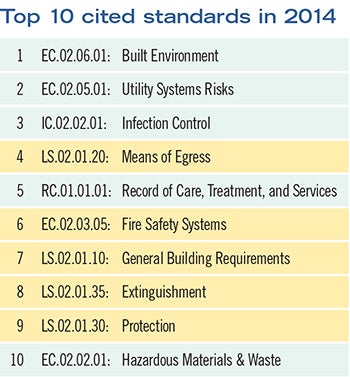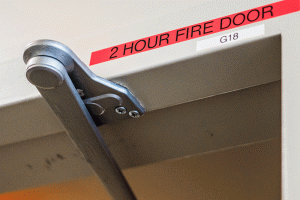Complying with fire safety codes
 |
| The yellow highlighted Joint Commission standards cover fire system-related issues. |
Many health care organizations commit substantial resources to complying with the fire and life safety provisions required for licensure, certification and accreditation.
Time is spent participating in a variety of training opportunities to understand the issues and compliance challenges, as well as the changing code requirements. Consultants also are hired to perform life safety assessments of health care facilities, generating reports citing any deficiencies.
More recently, the American Society for Healthcare Engineering, the Joint Commission, the Firestop Contractors International Association (FCIA) and Underwriters Laboratory have combined to provide barrier-management symposia to help facilities comply with some of the provisions that historically seem to be the most challenging.
All of these measures signal that fire safety compliance is an important part of the health facilities manager’s job that requires continual improvement.
Fire safety assistance
To further assist in these efforts, this article traces five of the most common fire and life safety findings cited by the Joint Commission, using several years of data. In addition, the article will explore compliance strategies that can help health care organizations do even better in the future.
You may also like |
| Initiative helps prevent surgical fires |
| Lean approach to codes and standards |
| Time to get fully sprinklered |
| |
1. Means of egress. Although the number of citations dropped from 52 to 50 percent between 2013 and 2014, Joint Commission Standard LS.02.01.20, Means of Egress, was the life safety or fire safety standard most commonly cited for noncompliance. The standard includes such things as door locking, door swing, horizontal exits, exit discharge and stair doors being propped open. With the increasing emphasis on security, door-locking issues may continue to increase in health care facilities. The Life Safety Code provides for certain security arrangements for egress doors, and the options have increased in the 2012 edition of the National Fire Protection Association’s NFPA 101, Life Safety Code. It should be noted that some of the new provisions in the 2012 edition are included in the categorical waivers permitted by the Centers for Medicare & Medicaid Services (CMS) [see Item 4 in Survey and Certification (S&C) reference 13-58-LSC].
In addition to security issues, element of performance (EP) 9 addresses stair doors that are improperly held open. While this is an operational issue that might be corrected with training, it also should be noted that the code permits such doors to be automatic — closing by smoke detection. Therefore, if this is an ongoing problem in a health care facility, one strategy to achieve ongoing compliance would be to change the door from being self-closing to automatic-closing. This corrective action will include providing a magnetic hold-open device for the door, automatic smoke detection near the door and connection to and programming of the fire alarm system to meet the automatic-closing requirements.
Lastly, this standard addresses issues commonly referred to as “corridor clutter” or keeping the egress corridors clear and unobstructed. While this, too, is a training and operational issue, it is also addressed by the categorical waivers [S&C 12-21-LSC and Item 8 of S&C 13-58-LSC]. The categorical waiver establishes consistent criteria for wheeled carts, emergency carts and patient transport equipment that might be located in a corridor. Use of the categorical waiver can help to reduce the instances in which a facility may be cited for a noncompliant condition.
2. Fire safety systems. While the citations involving means of egress decreased slightly from 2013 to 2014, the citations for noncompliance with Joint Commission Standard EC.02.03.05 have increased slightly from 45 to 48 percent. This standard addresses proper inspection, testing and maintenance of automatic sprinkler systems, portable fire extinguishers and fire alarm systems, among others. While there is some relaxation in the requirements permitted by the CMS categorical waivers [see Item 6 in S&C 13-58-LSC], in many instances, the citations are due to the lack of proper maintenance of all the components of the respective fire protection systems. One question a health care organization might ask is whether all the devices on the systems are known. If there is no inventory of the components for such systems, it is impossible to know that all valve supervisory switches, detectors, waterflow-alarm switches and other equipment are being properly inspected and tested.
Related to this, contractors who perform such services often find that tests that are required every three or five years, such as the standpipe flow test, are not being performed because the contractors are being contracted for annual service of the system. This was an item of focus identified by the Joint Commission and may be one of the reasons for the increase. It also should be noted that while the Joint Commission identifies some specific inspection, test and maintenance activities in the standard, the actual requirement in NFPA 101 is to inspect, test and maintain the fire protection systems in accordance with the NFPA standards, such as NFPA 25 and NFPA 72. Failure to perform the tasks required by the reference standards also can result in a finding by a Joint Commission surveyor.
Another concern expressed by contractors who perform such services is that some facility owners do not correct the deficiencies that were cited during previous inspections and tests. Because several years of records are required to be maintained, failure to correct noted deficiencies in a timely manner may also result in a finding. The barrier-management symposia may be helping facilities to comply with certain standards based upon the data provided by the Joint Commission. If the upward trend continues, a similar symposium addressing inspection, testing and maintenance of fire protection systems may be helpful.
3. General building requirements. Another Joint Commission standard for which the rate of noncompliance has decreased slightly from 2013 to 2014 (48 to 46 percent) is LS.02.01.10. This standard includes items such as building construction type and openings and penetrations of fire barriers. Clearly opening protective assemblies (i.e., doors and windows) as well as penetrations (i.e., through-penetration firestop systems) are included in the barrier-management symposia. For those who have not yet attended a program, future program dates and copies of the slide presentations are available on the FCIA website.
Another consideration — and one that is mentioned during the barrier symposia — is to develop and maintain accurate life safety drawings. Historically, facilities have been cited for fire-barrier deficiencies based upon incomplete or inaccurate life safety drawings. As health facilities professionals increase the extent to which health care facilities are protected with an automatic sprinkler system, they also should evaluate whether some of the fire barriers are still required. When doing such an analysis, they should evaluate the compliance based upon the requirements for a new health care occupancy as opposed to an existing occupancy.
4. Extinguishment. One of the more significant increases between 2013 and 2014 is the number of noncompliance findings cited for LS.02.01.35. While the ranking of LS.02.01.35 has increased slightly [see table on Page 45], the percentage of noncompliance has increased from 36 to 43 percent. The standard addresses issues like support of automatic sprinkler pipe, damage to automatic sprinklers and clearance beneath automatic sprinklers.
Maintaining proper clearance beneath automatic sprinklers is an ongoing issue for health care facilities. Painting the upper surfaces of storage room walls or providing a line at the proper elevation on the walls are good ways to identify how high storage may be in such rooms. It also should be remembered that the required clearance beneath sprinklers — typically 18 inches beneath the deflector — is a horizontal plane at that elevation. Unfortunately, some people incorrectly interpret the requirement as the need to keep items 18 inches away from automatic sprinklers.
Another common finding is that facilities use the sprinkler system pipe and hangers to support other objects, such as cable being supported by hanging it from sprinkler pipes. While the presence of a limited amount of cable is not likely to cause the sprinkler hanger to fail, the presence of the cables, especially when they are bundled near a sprinkler, also can be an obstruction to the sprinkler discharge pattern. Facilities professionals should be aware that the sprinkler system is not to be used to support other items.
These items, as well as damaged sprinklers and sprinklers that are coated or painted, should be identified during the annual inspection of the sprinklers, as required by NFPA 25, Standard for the Inspection, Testing, and Maintenance of Water-Based Fire Protection Systems. Whereas much of the sprinkler pipe in health care facilities is in concealed spaces, NFPA 25 does not require such piping to be inspected annually. However, as one goes above the ceiling to inspect penetrations and the continuity of fire barriers, the use of the sprinkler system to support other items also should be evaluated.
5. Protection. The largest drop in ranking between 2013 and 2014 is with LS.02.01.30 [see table on Page 45]. The percentage of noncompliant findings has dropped from 45 to 43 percent in that same period. The standard addresses such things as vertical openings, hazardous areas, gift shops, and corridor walls and doors. Again, the content of this standard is included in the content of the barrier-management symposia. In addition, the increased presence of sprinkler protection may be contributing to the reduction since the requirements for corridor walls and doors decreases when the smoke compartment is protected with an automatic sprinkler system. Accurate life safety drawings also can assist in properly documenting compliance with this standard.
Making progress
Several Joint Commission standards covered by the barrier-management symposia show a decrease in the percentage of noncompliant findings by surveyors as well as a decrease in the overall ranking of noncompliance findings. The database is not yet large enough to conclusively identify the symposia as the major reason why these decreases are occurring, but it would seem that they are at least a contributing factor.
However, the data also indicate that much work needs to be done regarding noncompliance of standards related to fire safety systems and extinguishing systems in health care facilities. To make a difference, a level of effort similar to that being committed to barrier management also needs to be applied to the fire safety systems and extinguishing systems in health care facilities.
William E. Koffel, P.E., FSFPE, is president of Koffel Associates Inc., a fire protection engineering and code consulting firm based in Columbia, Md. Although he is chair of the NFPA Technical Committee on NFPA 25 and NFPA Life Safety Correlating Committee, the views and opinions expressed in this article shall not be considered the official position of NFPA or any of its technical committees and shall not be considered to be, nor be relied upon as, a formal interpretation. He can be reached at wkoffel@koffel.com.
Fire barrier symposia info
The American Society for Healthcare Engineering, the Joint Commission, the Firestop Contractors International Association (FCIA) and Underwriters Laboratory have teamed up to provide barrier-management symposia at various locations around the country.
The program focuses on the proper design, installation, inspection and maintenance of fire and smoke barriers and includes such features as firestopping, fire dampers, fire-rated glazing and fire doors, which can provide effective compartmentalization in health care facilities.
It educates about the testing that qualifies the products for use, code requirements, installation and inspection, and management and maintenance for ongoing reliability of the installed fire resistance-rated and smoke-resistant products.
The schedule of symposia can be found on the FCIA’s website.




